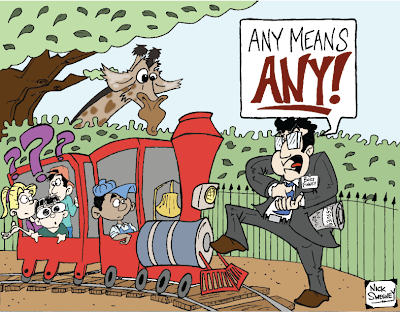Tag: issue 9
COAST has debuted their new yard signs that prominently feature a decorated bus (much like the Holly Jolly Trolley seen Downtown every holiday season and the special event trolleys that take people on tours of the city). The signs also simply state “Stop the Streetcar” instead of “We Demand a Vote” or “Stop All Passenger Rail” or “Any Means Any” or “No Taxation Without Representation” or “Lets Go Teabagging” or anything that would be closer to the truth.
When it comes down to the very core of COAST, and their stance on Issue 9, it’s not about Democracy, voting, or even empowering the public to keep their government in check. What Issue 9 is all about for COAST (a special interest political group that has fought everything from gay rights to red light cameras to funding for our public libraries and childrens museum) is permanently changing our city’s charter to more closely fit their political ideologies.
They’re paid to fight for this while the rest of us are not. Our city’s future is far to important to fall for the tricks of a special interest group looking out for no one else but themselves and their futures. A wise man once said, “follow the money trail.”
 Additional Reading:
Additional Reading:COAST’s yard signs: more nonesense – The Phony Coney
Jason Gloyd is a Liar or an Idiot…whichever title you prefer – CAAST
Cincinnatians for Progress (CFP) will be holding their final fundraiser of this campaign season on Tuesday, October 13 from 5:30pm to 8pm at Mecklenburg Gardens in Corryville. In addition to the food and drink, CFP will also unveil their television commercial and watch the Mayoral debate.
Mecklenburg Gardens is one of Cincinnati’s oldest restaurants and boasts that German charm Cincinnati is so well known for. There will be plenty of Mecklenburg’s famous German food, plus some of the best beer in town. General admission is only $30 and will help keep Cincinnati moving forward with rail transportation choices for its residents, visitors and workers alike. For those looking to contribute a little more, CFP has identified three additional levels of contributors: Danke Schon ($250), Lederhosen ($500), and Burgermeister ($1,000).
Mecklenburg Gardens (map) is just a hop, skip and a jump away from the proposed Uptown streetcar route and presently boasts nearby on-street parking for automobiles, bicycle racks, and is served by Metro’s #39, 46, 51, 75x and 78 bus routes that will all get you within a few blocks of the restaurant. To find out which route is most convenient for you, and to plan your trip now, use Metro’s Trip Planner.
Don’t Outlaw Choice
Often, those seeking to pass Issue 9 base their skepticism for rail transit on the idea that the success of such a system is unknowable. They claim that there is no way to tell the specific impacts an integrated transportation system will have on our city. Their argument is only true to a point. While pin-point specific data cannot be known until after a system begins operation, there is an ocean of data available from the scores of cities that have chosen to invest in this technology.
Look, if Cincinnati were the first city to come up with the idea of rail transportation, the opponents’ skepticism would be legitimate and welcomed. But we have already seen the effects in literally DOZENS of cities. The results are in and these systems work. The vast majority of their skepticism is baseless, unproductive, and downright ignorant when considering the amount of data that exists supporting rail transportation in its various forms.
Why would they attempt to ban all funding for a public good? Transportation is a public good with public benefits. Because transportation has public benefits and is considered a basic public service, transportation in ALL its forms (including roads) is publicly funded. Just as I-75 wasn’t funded by an individual or a company, neither should rail be. Local leaders need options of how to pay for this public service.
So where does the money come from? In many instances, the large public benefit of transit encourages federal and state funding. But if Issue 9 passes, the ability for Cincinnati leaders to obtain that funding becomes impossible. Federal dollars are highly competitive, and only the cities with the strongest and fastest applications will receive those dollars. Requiring a public vote will slow the process to the point where Cincinnati is taken out of the running. This leaves no choice for local leaders but to fund these projects with just local dollars.
Therefore, to pass Issue 9 is to eliminate choice. It eliminates the choice of city leaders to find funding. But more significantly, it eliminates the choice of how Cincinnatians live.
Passing Issue 9 will outlaw the choice to either drive or take a commuter train to work in the morning.
Passing Issue 9 will outlaw the choice of Cincinnatians to either drive or ride high-speed rail to that conference in Chicago, that protest in DC, that OSU game in Columbus, that concert in St. Louis, that holiday in New York City.
Passing Issue 9 would outlaw the choice to take a train to Bengals game, or pay for $3/gal gas and $15 for parking on top of $80 dollar tickets and $8 beers.
Passing Issue 9 eliminates the choice between having a worry-free night on the town, or having to call it an early night so as to not drive while intoxicated.
Don’t outlaw choice. Vote No on Issue 9.
For more information, visit Cincinnatians for Progress. There you can see who else wants to preserve choice, check out their blog, see other reasons why Issue 9 leads to ineffective governance, sign up to volunteer, request a yard sign, or even donate to the cause.
Boss Finney: Sorry Kids
 Cartoon by Nick Sweeney
Cartoon by Nick Sweeney
